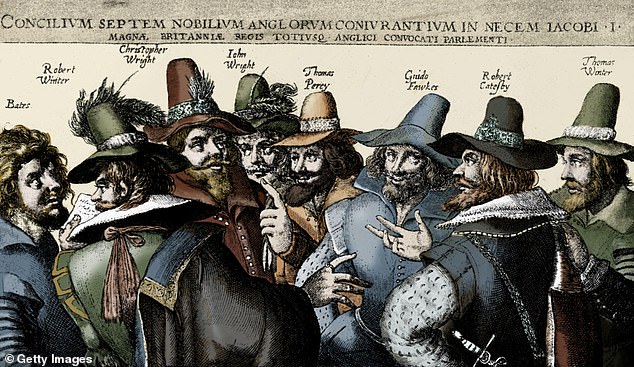[ad_1]
It was 419 years ago today that one of the most catastrophic episodes in English history was only narrowly averted.
In the early hours of November 5th, 1605, Guy Fawkes was caught under London‘s House of Lords with a box of matches and 36 barrels of gunpower.
Along with his fellow Catholic conspirators, Fawkes was found guilty of trying to blow up Parliament and assassinate James I of England.
Fortunately, the disastrous blast was foiled, no doubt saving the lives of thousands, not to mention the king and members of the Houses of Parliament.
Fawkes, meanwhile, was tortured on the rack before being tried for high treason in January 1606.
Ever since, the question still persists – what would have happened had the dastardly Gunpowder Plot been successful?
MailOnline’s interactive map gives an idea of the kind of devastation that would have occurred had 2,500kg of gunpowder been set alight.
Had Fawkes not been found by royal authorities, Westminster and the surrounding areas could look very different today.

In what became known as the Gunpowder Plot, Catholic conspirators led by Robert Catesby (depicted above with Guy Fawkes and other plotters) fatefully planned to kill James I by blowing up Parliament in 1605
MailOnline’s map is based on a 2003 analysis by the Centre for Explosion Studies at the University of Wales, Aberystwyth, led by Dr Geraint Thomas.
The researchers found the explosion would have destroyed Westminster Hall and Westminster Abbey, the Houses of Parliament and more.
Of course, the Houses of Parliament as we know it today were built in the 19th century following a fire, but Fawkes would have hastened its demise.
Jewel Tower, part of the Palace of Westminster from the 14th century, could have been partially damaged, as well as Whitehall – the site of Downing Street today.
Within a radius of about 130 feet, everything would have been razed to the ground, while up to 360 feet away buildings would have been at least partially destroyed.
Up to around 3,000 feet, some windows would have been blown out and Londoners would have felt the force of the blast.
Even further from the heart of the blast, lesser effects such as the sound of a faint bang may have been audible.
Dr Thomas and colleagues based their estimate on the assumption that the gunpowder would have been as powerful as TNT today.

The cellar beneath the House of Lords, as illustrated in 1799, where Guy Fawkes was found with the gunpowder, thought to no longer exist. It was described as 77 feet long, 24 feet and 4 inches wide, and 10 feet high

Fawkes was just one of 13 co-conspirators; he is most famous because he was the one caught as he was guarding the explosives, not because he was the ringleader
‘Fawkes was an expert in explosives and if he had the powder well packed in barrels, it would have an equivalent blast radius to modern TNT,’ Dr Thomas said.
The study referred to models given during the world wars regarding TNT detonation and how much damage that would cause depending on distance.
‘Admittedly we do not know the exact composition of the gunpowder or where it was placed in relation to structural walls,’ said co-author Cathy Gardner.
‘It is hard to say the exact damage that would have been caused and the Houses of Parliament might still have been standing, just about – but the building would not have been in a good state.’
In all, 36 barrels of gunpowder totaling 2,500kg were stored in a cellar underneath the House of Lords – a space that no longer exists.
The intention had been to detonate them during the State Opening of Parliament on November 5, when James I, the Queen and his heir would also be present.
The plot was hatched by Robert Catesby when it had become clear that King James I, who came to power in 1603, was going to continue the persecution of Catholics carried out by his predecessor Queen Elizabeth I.
It’s known that Fawkes – an explosives expert who had served in the Spanish army – used substantially more gunpowder than he needed.

In 2005, to mark the 400th anniversary of the Gunpowder Plot, a full-size replica of the House of Lords was built and destroyed with barrels of gunpowder at RAF Spadeadam in Cumbria, England
Originally from York, Fawkes’ job was to light the fuse and escape across the Thames – but with hours to go he was found during a royal search following a tip-off.
An anonymous letter of warning was sent to William Parker, 4th Baron Monteagle, a Catholic member of Parliament, who immediately showed it to the authorities.
An extract reads: ‘They shall receive a terrible blow this parliament and yet they shall not see who hurts them’.
Royal guards searched The House of Lords and in the early hours of November 5, Fawkes was found in the cellars, with a fuse, a small lamp, a box of matches and 36 poorly-hidden barrels of gunpowder.
After Fawkes’s arrest, Catesby and the other plotters fled the 80 miles from London back to Ashby St Ledgers in Northamptonshire in seven hours.
Catesby died two days later in a shootout as he attempted to resist arrest at Holbeach House in Staffordshire.
His head was later cut off and taken to London, where it was stuck on the roof Parliament.
Fawkes and fellow conspirators Thomas Wintour, Ambrose Rookwood and Robert Keyes were hanged, drawn and quartered in the Old Palace Yard, opposite Parliament at Westminster.
Fawkes’s death came after he was subjected to three months of interrogation and torture.
His signature on the confession he made on November 9 was barely legible, demonstrating the impact of the torture.
[ad_2]
READ SOURCE














